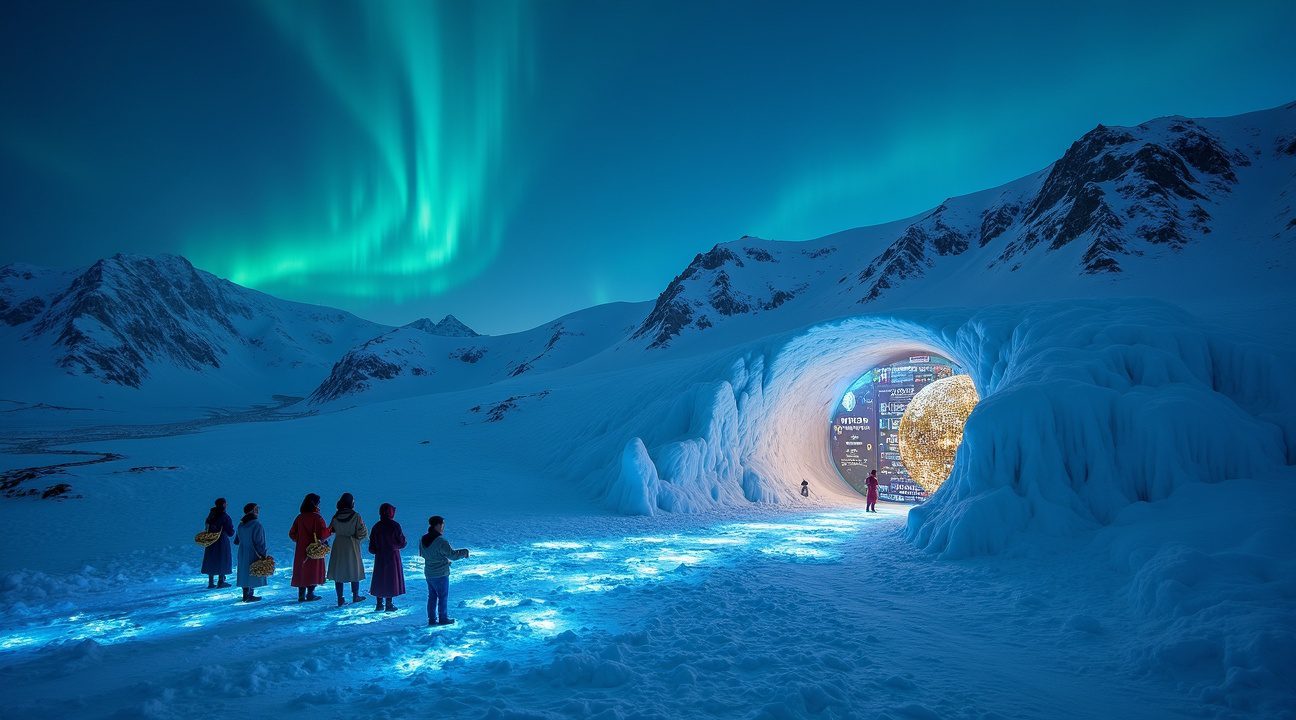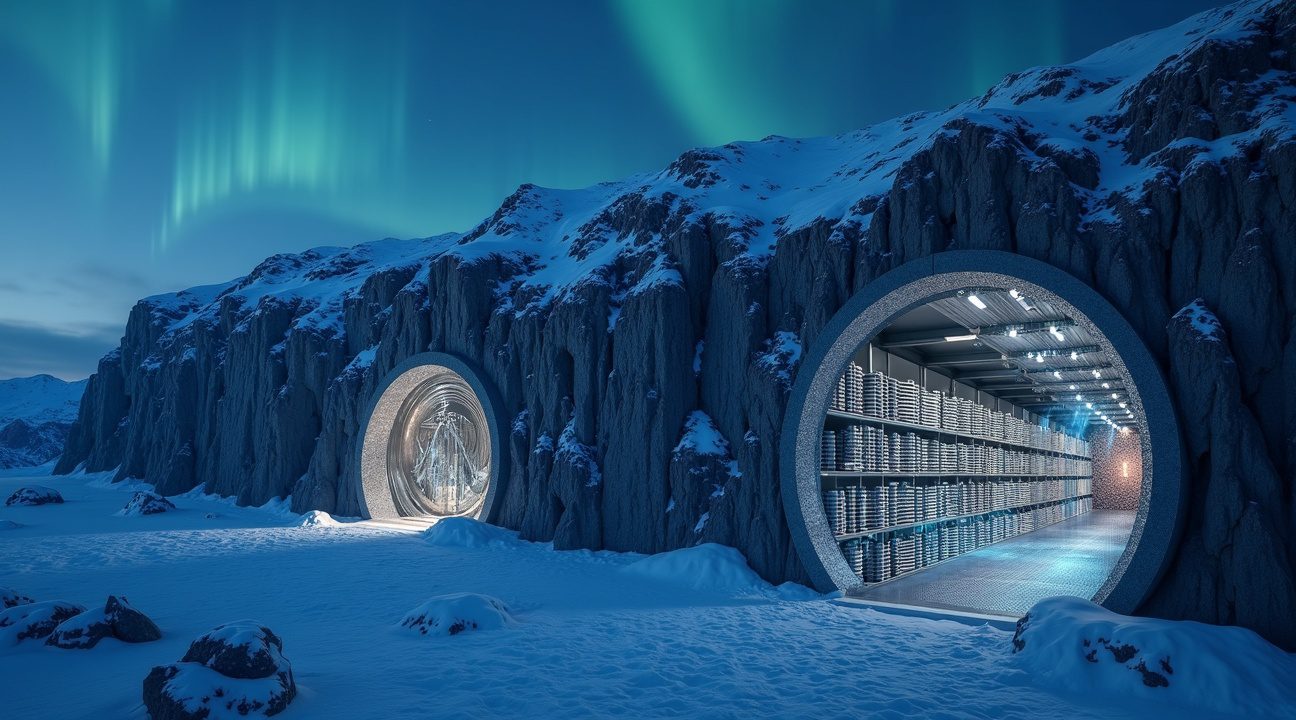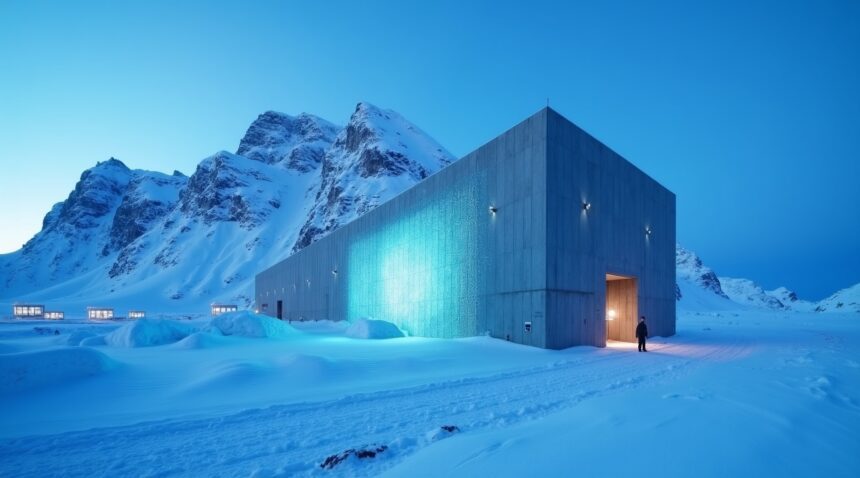The Svalbard Global Seed Vault serves as humanity’s ultimate safeguard for agricultural diversity, securing over 1.3 million seed accessions from 6,000+ species in a high-security Arctic facility nested deep inside a mountain in Norway.
Key Takeaways
- Massive capacity: The vault can accommodate up to 4.5 million seed varieties and currently contains 1.35 million accessions sourced from over 89 genebanks and represented by 223 countries and territories.
- Advanced preservation methods: Seeds are stored at -18°C in specially engineered foil packages, deep inside a 145.9-meter tunnel into the Platåberget mountain, enhanced by both mechanical refrigeration and the surrounding natural permafrost.
- Global diversity: Contributions include 95 million seeds from India alone. The vast collection includes staples like rice and wheat, as well as rare regional varieties, with all genetically modified organisms (GMOs) strictly excluded.
- Depositor-ownership model: Original contributors maintain ownership and exclusive withdrawal rights for their deposits. The system has already been used to restore critical seed collections, notably those lost during the Syrian conflict.
- International collaboration: The Norwegian government funded the initial $9 million construction and contributes to ongoing operational costs of approximately €1 million per year. The facility is jointly managed by the Norwegian Ministry of Agriculture, NordGen, and the Crop Trust.
This unparalleled “Doomsday Vault” stands as a testament to global cooperation and foresight, ensuring agricultural resilience for future generations amid an unpredictable world.
The “Doomsday Vault” Protecting Global Food Security
I’ve witnessed how the Svalbard Global Seed Vault has earned its dramatic nickname as the “Doomsday Vault” through its critical mission to safeguard humanity’s agricultural future. This remarkable facility stands as the ultimate insurance policy against catastrophic threats to our global food supply. Located on the remote Norwegian island of Spitsbergen within the Svalbard archipelago near the Arctic Circle, this vault represents humanity’s most ambitious effort to preserve crop diversity for future generations.
The facility’s importance hasn’t gone unnoticed by prestigious institutions worldwide. Time magazine recognized the Svalbard Global Seed Vault by ranking it No. 6 in their Best Inventions of 2008, acknowledging its revolutionary approach to agricultural preservation. Even more impressive, the Project Management Institute named it the 10th most influential project of the last 50 years, cementing its status as a global icon of forward-thinking conservation.
Critical Protection Against Global Threats
I understand that this facility serves as humanity’s safety net against numerous catastrophic scenarios that could threaten global food security. The vault protects against natural disasters like earthquakes, floods, and extreme weather events that can devastate regional seed banks. War poses another significant threat, as conflicts have historically destroyed agricultural resources and research facilities, making backup storage essential.
Human mismanagement represents an equally dangerous risk to our food supply. Equipment failures at smaller facilities, funding cuts to agricultural programs, and poor storage practices can all lead to irreversible losses of valuable genetic material. Climate change adds another layer of urgency, as shifting weather patterns threaten traditional crop varieties and growing regions worldwide.
Strategic Arctic Location Advantages
I’ve observed how the vault’s Arctic location provides multiple layers of protection that make it nearly indestructible. Spitsbergen’s permafrost creates natural refrigeration that helps preserve seeds even without electricity. The island’s remote location and stable political climate under Norwegian sovereignty provide security from human conflicts and interference.
The facility burrows deep into a mountainside, creating additional protection from external threats. This underground design protects against nuclear events, extreme weather, and potential sea-level rise. Norway’s commitment to maintaining the site ensures long-term stability, while international cooperation agreements protect the vault’s neutrality.
Advanced technology systems monitor temperature and humidity continuously, maintaining optimal storage conditions for centuries. The vault can hold up to 4.5 million seed varieties, representing the most comprehensive agricultural backup system ever created. Multiple security measures protect against unauthorized access while allowing legitimate researchers and institutions to deposit and withdraw materials.
International collaboration has made this project possible, with countries worldwide contributing seeds and funding. The facility operates as a true global resource, transcending political boundaries to serve all humanity. Organizations from developing nations can preserve their unique crop varieties alongside seeds from major agricultural powers.
The vault’s reputation extends beyond scientific circles into popular culture, where it’s frequently referenced in discussions about humanity’s survival and preparedness. Post-apocalyptic scenarios often feature similar facilities, highlighting how the concept resonates with public imagination about protecting civilization’s future.
I’ve seen how this facility transforms abstract concepts of food security into tangible action. By preserving genetic diversity from crops around the world, the Svalbard Global Seed Vault ensures that future generations will have access to the raw materials needed to develop climate-resistant varieties and maintain agricultural productivity. This foresight makes it not just a storage facility, but humanity’s most important investment in long-term survival and prosperity.
The “Doomsday Vault” represents more than just cutting-edge preservation technology – it embodies humanity’s commitment to learning from past agricultural losses and preparing for an uncertain future. Through this remarkable facility, we’ve created a lasting legacy that will serve generations to come.

Massive Storage Capacity Housing Millions of Seeds
The Svalbard Global Seed Vault stands as one of the most ambitious storage facilities ever constructed, designed to safeguard agricultural biodiversity on an unprecedented scale. I find the sheer numbers behind this operation absolutely staggering – the vault can hold up to 4.5 million seed samples, with each sample containing approximately 500 individual seeds. This translates to a potential storage capacity of 2.25 to 2.5 billion seeds, representing humanity’s most comprehensive agricultural insurance policy.
Current Holdings and Diversity
As of June 2025, the facility houses 1,355,591 accessions, protecting hundreds of millions of individual seeds from over 6,000 different species. This remarkable collection represents the collaborative efforts of countries worldwide to preserve their agricultural heritage.
Each accession serves as a genetic time capsule, containing varieties that might otherwise disappear due to climate change, natural disasters, or human conflict. The diversity stored here ranges from ancient grain varieties to modern crop cultivars, ensuring future generations will have access to the genetic resources needed for food security.
Architectural Design and Future Expansion
The vault’s physical structure reflects careful planning for long-term expansion needs. Engineers designed three identical storage halls, each measuring 9.5 by 27 meters, with the capacity to house roughly 1.5 million seed samples per hall. Currently, only one hall operates actively, while the remaining two await future activation as storage demands grow. This phased approach allows for efficient operation while maintaining the infrastructure needed for expansion.
The facility extends approximately 145.9 meters from entrance to back, creating a substantial underground complex carved into the Arctic permafrost. Each storage room maintains specific dimensions – widths of 9.5 to 10 meters, lengths of 27 meters, and heights of 6 meters – optimized for both accessibility and climate control.
These measurements weren’t chosen arbitrarily; they represent the perfect balance between maximizing storage capacity and maintaining the precise environmental conditions necessary for long-term seed preservation. The design ensures that even as extreme weather patterns continue to impact global agriculture, this vital genetic repository remains secure and accessible for centuries to come.
Global Collaboration Preserving Crop Diversity from Every Continent
I find the scale of international cooperation behind the Svalbard Global Seed Vault truly remarkable. The facility receives contributions from over 89 genebanks spanning more than 60 countries, effectively representing a staggering 223 countries and territories worldwide. This massive collaborative effort demonstrates humanity’s shared commitment to preserving agricultural biodiversity for future generations.
Major Contributors and Their Contributions
India stands as the largest single contributor, having deposited over 95 million seeds into the vault’s protective chambers. The International Rice Research Institute and the USDA have also made substantial contributions, reinforcing the vault’s mission to safeguard the world’s most critical food crops. These organizations understand that genetic diversity serves as agriculture’s insurance policy against climate change, disease outbreaks, and other threats to food security.
The vault’s collection showcases an impressive array of both staple and specialty crops. Rice dominates the repository with 85 million seeds, followed by significant quantities of wheat, maize, barley, and potatoes. However, the collection extends far beyond these familiar crops to include lesser-known but equally important varieties like sorghum, cowpea, and millet.
- Legumes comprise 9% of all stored seeds
- Fruits and vegetables round out the comprehensive collection
Preserving Rare and Regional Varieties
What makes this repository truly special is its commitment to preserving both common commercial varieties and rare regional cultivars that might otherwise disappear. Local farmers across continents have developed unique crop varieties over thousands of years, adapting plants to specific climates, soils, and cultural preferences. These traditional varieties often possess traits that could prove invaluable for future breeding programs, such as resistance to drought, pests, or diseases.
The vault maintains strict standards regarding what it accepts. Genetically modified organisms (GMOs) are explicitly excluded from the collection, ensuring that only naturally occurring genetic diversity is preserved. This policy reflects the vault’s focus on maintaining authentic genetic resources that have evolved through natural selection and traditional breeding practices.
Seeds arrive at the vault from every continent, creating the planet’s most diverse backup repository for plant genetic resources. African contributors send drought-resistant varieties of millet and sorghum, while Asian genebanks deposit ancient rice cultivars that have fed billions for millennia. South American collections include potato varieties from the Andes, where these tubers were first domesticated thousands of years ago. Rare varieties from remote islands and isolated mountain valleys find safe harbor alongside crops from the world’s major agricultural regions.
European research institutions contribute heritage wheat varieties and ancient grains, while North American genebanks deposit both wild relatives of crops and improved cultivars developed through decades of scientific breeding. Australian and New Zealand contributors add unique varieties adapted to their continent’s challenging growing conditions.
The collaborative nature of this project transcends political boundaries and cultural differences. Countries that might disagree on other issues unite in their recognition that crop genetic diversity represents a global heritage that must be protected. Scientists travel globally to collect seeds from remote locations, often working with indigenous communities who have served as guardians of these genetic treasures for generations.
This international partnership creates redundancy that strengthens global food security. If a natural disaster, conflict, or other catastrophe destroys a regional genebank, the Svalbard vault provides a backup copy that can restore lost varieties. The facility has already fulfilled this mission several times, returning seeds to institutions in countries like Syria and the Philippines after their local collections were damaged or destroyed.
The vault’s commitment to preserving genetic resources from every corner of the Earth ensures that future plant breeders will have access to the full spectrum of natural genetic variation. Climate change threats make this diversity increasingly valuable as scientists work to develop crops that can withstand rising temperatures, changing precipitation patterns, and evolving pest pressures.

Advanced Preservation Technology in an Arctic Fortress
The Svalbard Global Seed Vault operates as a highly sophisticated preservation facility, utilizing both cutting-edge technology and nature’s own protective elements. I’ve observed how this combination creates one of the most secure storage environments on Earth for our planet’s agricultural heritage.
Precision Temperature Control and Natural Protection
Seeds within the Vault remain frozen at exactly -18°C, a temperature carefully calibrated to maximize their long-term viability. This artificial cooling system works in harmony with the mountain’s natural permafrost, where ambient rock temperatures hover between -3 to -4°C year-round. The dual-layer protection ensures that even if mechanical systems fail, the seeds benefit from nature’s own refrigeration system.
The facility’s location inside Platåberget (“Plateau Mountain”) provides exceptional stability. Engineers carved the Vault more than 100 meters deep into the mountainside, creating a fortress-like environment that officially opened on 26 February 2008. This depth shields the collection from surface temperature fluctuations and external threats.
Advanced Packaging and Security Systems
Each seed deposit undergoes careful preparation using specially designed three-ply foil packages. These moisture-resistant containers prevent contamination while maintaining optimal storage conditions. I find the protective box system particularly impressive, as it creates multiple barriers against environmental hazards that could compromise seed integrity.
Security protocols match those found at major airports, with comprehensive scanning of all seed shipments upon arrival. The facility’s remote Arctic location provides natural protection from geopolitical conflicts, while its resilient architecture withstands various natural and human-made threats. Even extreme weather events pose minimal risk to the collection housed deep within the mountain.
The Vault’s entrance features “Perpetual Repercussion,” an art installation by Dyveke Sanne that serves both aesthetic and symbolic purposes. This striking visual element represents humanity’s commitment to preserving biodiversity for future generations while marking the entrance to one of our most important repositories.
Modern monitoring systems track temperature, humidity, and structural integrity continuously. The facility’s design accounts for potential challenges ranging from seismic activity to climate change, ensuring that the precious genetic resources remain viable for centuries. Advanced technology supports every aspect of operation, from automated climate control to sophisticated access systems.
The combination of human engineering and natural Arctic conditions creates an almost impenetrable preservation environment. This dual approach ensures that critical agricultural genetic material stays protected regardless of global events or technological failures.

How Deposits and Withdrawals Actually Work
The Svalbard Global Seed Vault operates on a straightforward principle that protects depositor rights while serving as humanity’s agricultural insurance policy. Depositing institutions maintain complete ownership of their seed samples, meaning only the original depositor has the authority to retrieve their stored materials. This system ensures that countries and organizations retain sovereignty over their genetic resources while benefiting from the Vault’s secure storage capabilities.
The Deposit Process and Frequency
Deposits occur multiple times each year through carefully coordinated openings. During 2021, the Vault welcomed contributions from 22 genebanks across three separate deposit events, adding nearly 51,000 seed samples to its collection. These scheduled openings allow institutions worldwide to contribute their most valuable genetic material in an organized manner.
The process involves rigorous documentation and packaging standards to ensure long-term viability. Each depositing organization must provide detailed information about their samples, including:
- Species identification
- Collection location
- Storage requirements
Plant breeders and researchers work closely with their respective genebanks to identify priority varieties for deposit.
Real-World Recovery Operations
The Vault’s true value becomes apparent during disaster recovery situations. A prime example occurred when the International Center for Agricultural Research in the Dry Areas needed to recover collections that had been compromised by devastating events in Aleppo. This organization successfully retrieved their stored seeds from Svalbard, demonstrating how the backup facility fulfills its core mission.
These withdrawal operations follow strict protocols. The original depositor must formally request their materials and provide justification for the retrieval. Once approved, the seeds are carefully extracted from their frozen storage and shipped back to the requesting institution. The entire process maintains the chain of custody while ensuring that genetic material reaches those who need it most.
Commercial exploitation isn’t permitted under any circumstances. Every seed stored in the Vault serves conservation, research, or disaster recovery purposes. This restriction protects against the commercialization of genetic resources while ensuring that the facility remains focused on its humanitarian mission.
The withdrawal system has proven essential for maintaining global food security. When natural disasters, conflicts, or climate events threaten regional seed collections, researchers can quickly access backup materials from Svalbard. This capability allows agricultural scientists to rebuild lost collections and continue their vital work developing climate-resilient crop varieties.
Funding and Partnership Behind the World’s Most Important Vault
The Norwegian government took full financial responsibility for constructing the Svalbard Global Seed Vault, investing approximately USD 8.8–9 million (around 45 million NOK) in the initial construction. This substantial investment demonstrates Norway’s commitment to global food security and its recognition of the vault’s critical importance for humanity’s future.
Beyond the initial construction cost, the facility has undergone significant improvements over the years. A major technical upgrade required additional funding of about EUR 20 million, ensuring the vault maintains its cutting-edge preservation capabilities and adapts to evolving technological standards. These enhancements have strengthened the facility’s ability to protect its invaluable cargo against environmental challenges and potential technical failures.
Operational Costs and Management Structure
The vault’s annual operations require approximately EUR 1 million to maintain proper functioning. This ongoing investment covers essential services including climate control, security systems, monitoring equipment, and facility maintenance. The operational budget ensures that seeds remain viable for centuries while maintaining the strict environmental conditions necessary for long-term preservation.
Management of this crucial facility operates through a unique partnership model involving three key organizations:
- The Norwegian Ministry of Agriculture and Food provides governmental oversight and policy direction
- NordGen (Nordic Genetic Resource Center) contributes scientific expertise and regional coordination
- The Crop Trust brings international perspective and global agricultural knowledge
This collaborative approach combines governmental stability with scientific expertise and international cooperation. Each partner contributes distinct strengths that enhance the vault’s effectiveness. The Norwegian government provides political backing and financial security, while NordGen offers specialized knowledge in genetic resource management. The Crop Trust ensures global representation and maintains connections with agricultural communities worldwide.
The partnership structure also facilitates coordination with seed banks across the globe. This network approach allows the vault to serve as both a backup facility and a central hub for international seed conservation efforts. The collaborative model has proven effective in managing complex logistical challenges while maintaining the vault’s primary mission of preserving agricultural biodiversity for future generations.
Sources:
NordGen – “Frequently Asked Questions”
Oceanwide Expeditions – “Inside the Svalbard Global Seed Vault”
Wikipedia – “Svalbard Global Seed Vault”
Crop Trust – “FAQs”
Svalbardi – “What Seeds are in the Svalbard Global Seed Vault?”
Svalbard Global Seed Vault – “The Facility”
Crop Trust – “The Svalbard Global Seed Vault,” Crop Trust Annual Reports

